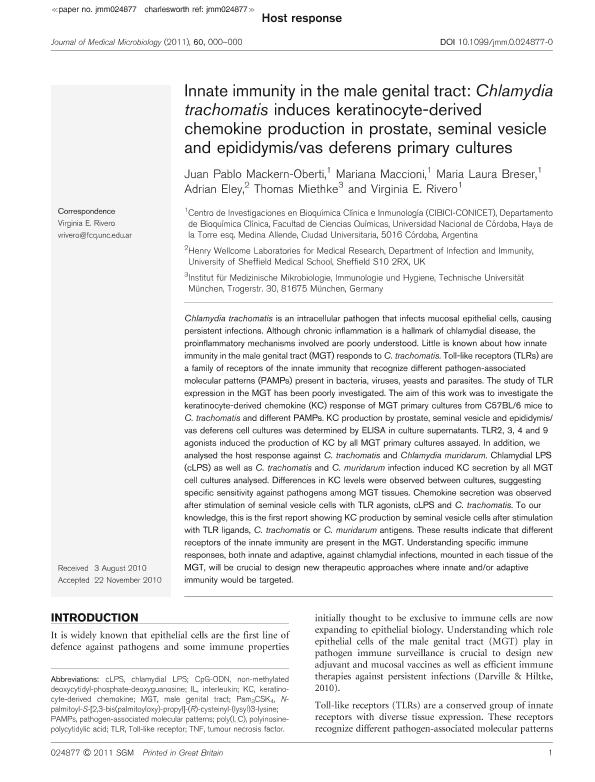Artículo
Innate immunity in the male genital tract: Chlamydia trachomatis induces keratinocyte-derived chemokine production in prostate, seminal vesicle and epididymis/vas deferens primary cultures
Mackern Oberti, Juan Pablo ; Maccioni, Mariana
; Maccioni, Mariana ; Breser, Maria Laura
; Breser, Maria Laura ; Eley, Adrian; Miethke, Thomas; Rivero, Virginia Elena
; Eley, Adrian; Miethke, Thomas; Rivero, Virginia Elena
 ; Maccioni, Mariana
; Maccioni, Mariana ; Breser, Maria Laura
; Breser, Maria Laura ; Eley, Adrian; Miethke, Thomas; Rivero, Virginia Elena
; Eley, Adrian; Miethke, Thomas; Rivero, Virginia Elena
Fecha de publicación:
03/2011
Editorial:
Society for General Microbiology
Revista:
Journal Of Medical Microbiology
ISSN:
0022-2615
Idioma:
Inglés
Tipo de recurso:
Artículo publicado
Clasificación temática:
Resumen
Chlamydia trachomatis is an intracellular pathogen that infects mucosal epithelial cells, causing persistent infections. Although chronic inflammation is a hallmark of chlamydial disease, the proinflammatory mechanisms involved are poorly understood. Little is known about how innate immunity in the male genital tract (MGT) responds to C. trachomatis. Toll-like receptors (TLRs) are a family of receptors of the innate immunity that recognize different pathogen-associated molecular patterns (PAMPs) present in bacteria, viruses, yeasts and parasites. The study of TLR expression in the MGT has been poorly investigated. The aim of this work was to investigate the keratinocyte-derived chemokine (KC) response of MGT primary cultures from C57BL/6 mice to C. trachomatis and different PAMPs. KC production by prostate, seminal vesicle and epididymis/ vas deferens cell cultures was determined by ELISA in culture supernatants. TLR2, 3, 4 and 9 agonists induced the production of KC by all MGT primary cultures assayed. In addition, we analysed the host response against C. trachomatis and Chlamydia muridarum. Chlamydial LPS (cLPS) as well as C. trachomatis and C. muridarum infection induced KC secretion by all MGT cell cultures analysed. Differences in KC levels were observed between cultures, suggesting specific sensitivity against pathogens among MGT tissues. Chemokine secretion was observed after stimulation of seminal vesicle cells with TLR agonists, cLPS and C. trachomatis. To our knowledge, this is the first report showing KC production by seminal vesicle cells after stimulation with TLR ligands, C. trachomatis or C. muridarum antigens. These results indicate that different receptors of the innate immunity are present in the MGT. Understanding specific immune responses, both innate and adaptive, against chlamydial infections, mounted in each tissue of the MGT, will be crucial to design new therapeutic approaches where innate and/or adaptive immunity would be targeted.
Palabras clave:
Male Genital Tract
,
Chlamydia Trachomatis
,
Innate Immunity
,
Cytokines
Archivos asociados
Licencia
Identificadores
Colecciones
Articulos(IMBECU)
Articulos de INST. DE MEDICINA Y BIO. EXP. DE CUYO
Articulos de INST. DE MEDICINA Y BIO. EXP. DE CUYO
Citación
Mackern Oberti, Juan Pablo; Maccioni, Mariana; Breser, Maria Laura; Eley, Adrian; Miethke, Thomas; et al.; Innate immunity in the male genital tract: Chlamydia trachomatis induces keratinocyte-derived chemokine production in prostate, seminal vesicle and epididymis/vas deferens primary cultures; Society for General Microbiology; Journal Of Medical Microbiology; 60; 3; 3-2011; 307-316
Compartir
Altmétricas



